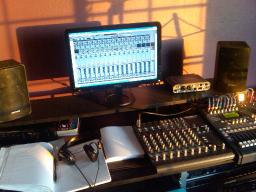

@rg
Home Studio - Bringing It Home

So just what can you do in a home studio? What is it, exactly, that you will be able to do once you have your studio set up? Even if you have no experience in this, you'll find that your natural talent and years of listening to wellproduced music have given you more tools than you thought you had. It's all about listening.
Recording
The most obvious thing you can do in a home studio is to record sound onto tape or disk. Whether you are learning to use microphones effectively or just plugging a keyboard in, recording covers the whole spectrum of capturing sound. For those who have never recorded before, the process can be very rewarding. Having the ability to come home from work and spend a few hours in your studio creating music is very freeing, and the icing on the cake is that you have total control. Whether you are making an elaborate multitrack masterpiece or simply singing and playing guitar, you need to know how to get a good sound. This is where you learn the basics of engineering: setting levels, choosing and placing the correct microphones for the best sound, and dealing with mixing. For the keyboard players out there, using MIDI (an electronic standard used for the transmission of digital music) is an important part of the recording process. All these elements fall under the umbrella of recording.
Mixing
Mixing is generally done after the initial recording sessions. Mixing is the art of setting the loudness and sound color of each instrument that you record. Mixing is a learned art, and like any other skill, it takes practice. Using faders to control the volume of tracks helps the instruments sound more cohesive and balanced. Equalization, which we will refer to as EQ, is the boosting or lowering of certain frequencies. EQ can transform a muddy bass into a clear sound, or turn a thin, lifeless guitar into a round, warm sound.
Effects are also a major component of mixing. Effects can help you achieve a more polished final sound. For instance, you can add reverb to give the illusion of having recorded in a large space or use compression to even out sudden changes in volume.
Editing
Editing can be considered cut, copy, paste, and whiteout for sound. In the world of editing you can cut a section and re-record it; you can go back and fix a note that sounds bad.
The most powerful editing options lie in the computer. Standalone, all-in-one recording units are capable of editing, but computer software takes it to a much higher level. Imagine that you are recording a song with a structure of chorus, solo, chorus. Suppose the choruses are exactly the same, and when you recorded the piece, the second chorus sounds better. Computer software gives you the ability to cut the first chorus and copy the second in its place. You don't even have to play repeat sections twice; you can just loop together small repeating bars of music. You can even click and drag sections of music around with your mouse. Did you decide after the fact that you want to record an introduction to your masterpiece? Just drag the original audio to the right, make room for the new, and paste it all together. This is just the tip of a very large iceberg…So now how do you get started? First, you've got to determine what your needs are.
